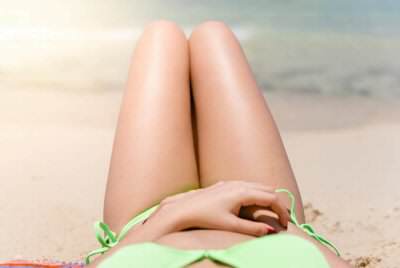
As Europeans cope with a record heatwave suffocating much of the continent, the importance of sun protection cannot be overstated.
Why should we be careful? How to choose and apply sunscreen properly? Euronews gathered a few tips from dermatologists.
Why sun protection matters
There is no such a thing as a healthy tan, dermatologists say.
“A tan is actually a sign that our skin has been harmed by UV radiation and is trying to defend itself against further damage. This kind of damage can, in turn, increase your risk of developing skin cancer,” the British Association of Dermatologists (BAD) warns.
There were over 140,000 new cases of melanoma of the skin across Europe In 2018, according to the Global Cancer Observatory, a majority of which is due to extensive sun exposure.
“In more than four out of five cases skin cancer is a preventable disease,” BAD said.
How to choose a sunscreen
“Look for one that is SPF 30 or higher,” Dr. Doris Day, a New York-based dermatologist, told Euronews. SPF stands for ‘sun protection factor’ and indicates how well a sunscreen protects you from sunburn.
Day said sunscreen should also be broad spectrum, meaning that it protects the skin from ultraviolet A (UVA) and ultraviolet B (UVB) rays, both of which can cause skin cancer.
It is preferable to pick a water-resistant sunscreen, according to the American Academy of Dermatology (AAD).
“The actual formulation of gel, lotion or cream is a personal preference, with gels being better for those who are more athletic and those with oily skin while creams are better for those with dry skin,” Dr. Day said.
There are essentially two types of sunscreen and they each have their pros and cons.
“Chemical sunscreens work like a sponge, absorbing the sun’s rays,” AAD explained. “These formulations tend to be easier to rub into the skin without leaving a white residue.”
“Physical sunscreens work like a shield, sitting on the surface of your skin and deflecting the sun’s rays,” AAD noted, adding: “Opt for this sunscreen if you have sensitive skin.”
How to apply sunscreen
Rule number one is that sunscreen should be applied generously.
“Studies have found that most people apply less than half of the amount required to provide the level of protection indicated on the packaging,” BAD said.
“Areas such as the back and sides of the neck, temples, and ears are commonly missed, so you need to apply it generously and be careful not to miss patches.”
While the amount required may vary depending on the type of product, AAD says most adults will need to use the equivalent of a ‘shot glass’ of sunscreen to fully cover their body.
Not only do you need to apply more sunscreen, but you probably also need to apply it more often. “Up to 85 per cent of a product can be removed by towel drying, so you should reapply after swimming, sweating, or any other vigorous or abrasive activity,” BAD recommends.
Last but not least, don’t forget to apply your sunscreen thoroughly.
“Studies show that if you are right handed you will apply more sunscreen to the right side of your face and, to the left side if your face if you are left-handed,” Dr. Day noted.
“Be sure to apply a generous layer to the entire face, I prefer starting with the outer face and ending with the nose, to make sure everything is covered. It’s also really important to cover the scalp or partline of your hair and the sides of the neck and also the chest,” Dr. Day continued.
Why sunscreen alone is not enough
“Even more important than sunscreen is being sun-smart,” Dr. Day said.
“This means: avoiding midday sun when possible, staying in the shade when possible, wearing a hat, sun protective clothing, sunglasses and sunscreen and reapplying sunscreen every few hours,” the dermatologist added.
“An easy way to remember is the shorter your shadow, the more dangerous the rays of the sun. At noon, your shadow is essentially zero because the sun is right above, that’s when the UVB rays are strongest and you have the highest chance of sunburn.”
Clothing also offers excellent sun protection. When possible, wear “a lightweight long-sleeved shirt, pants, a wide-brimmed hat and sunglasses,” as per AAD’s recommendations.
Sun protection under extreme heat
Under extreme heatwaves like the ones currently seen in Europe, it becomes even more important to be sun-smart.
“Stay hydrated since you can lose a good amount of water through your skin in the form of sweat,” Dr. Day said.
“ If you have headaches, change in vision or body temperature go to a doctor right away since this could be a sign of sun poisoning and could be life-threatening,” she added.
